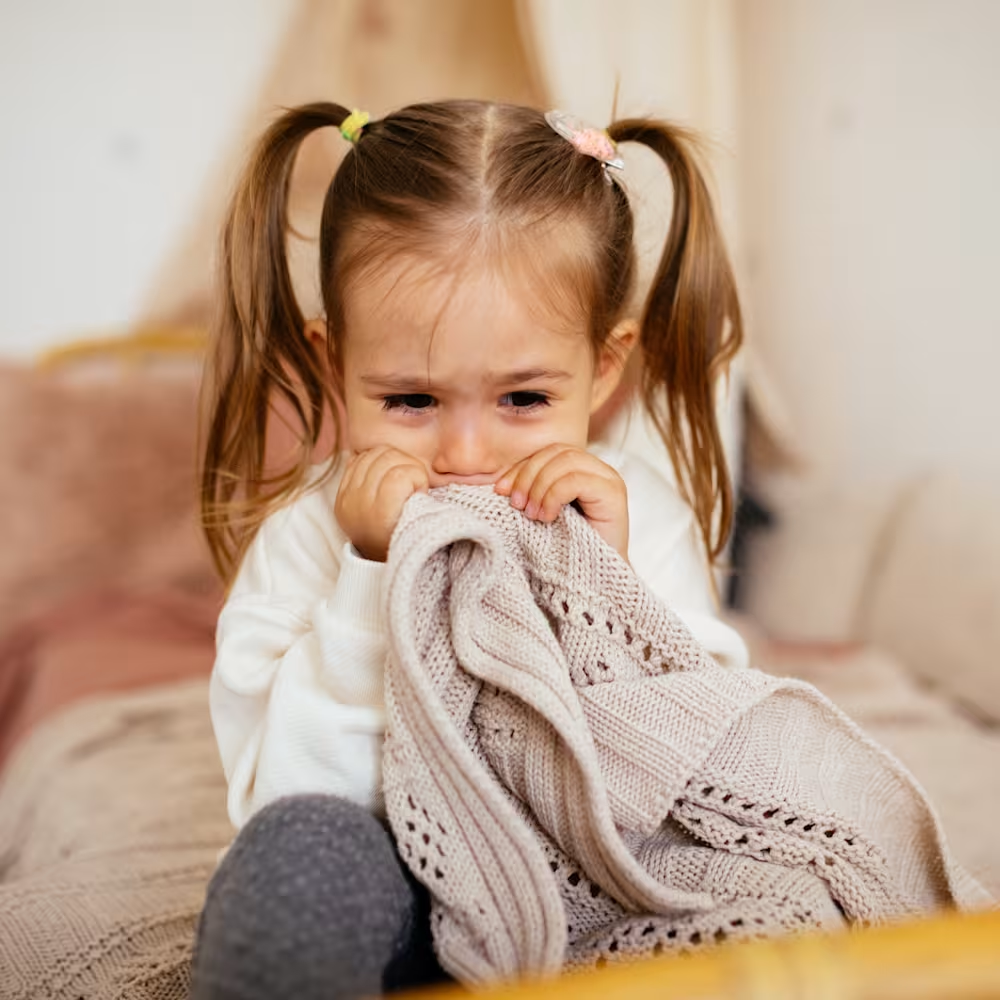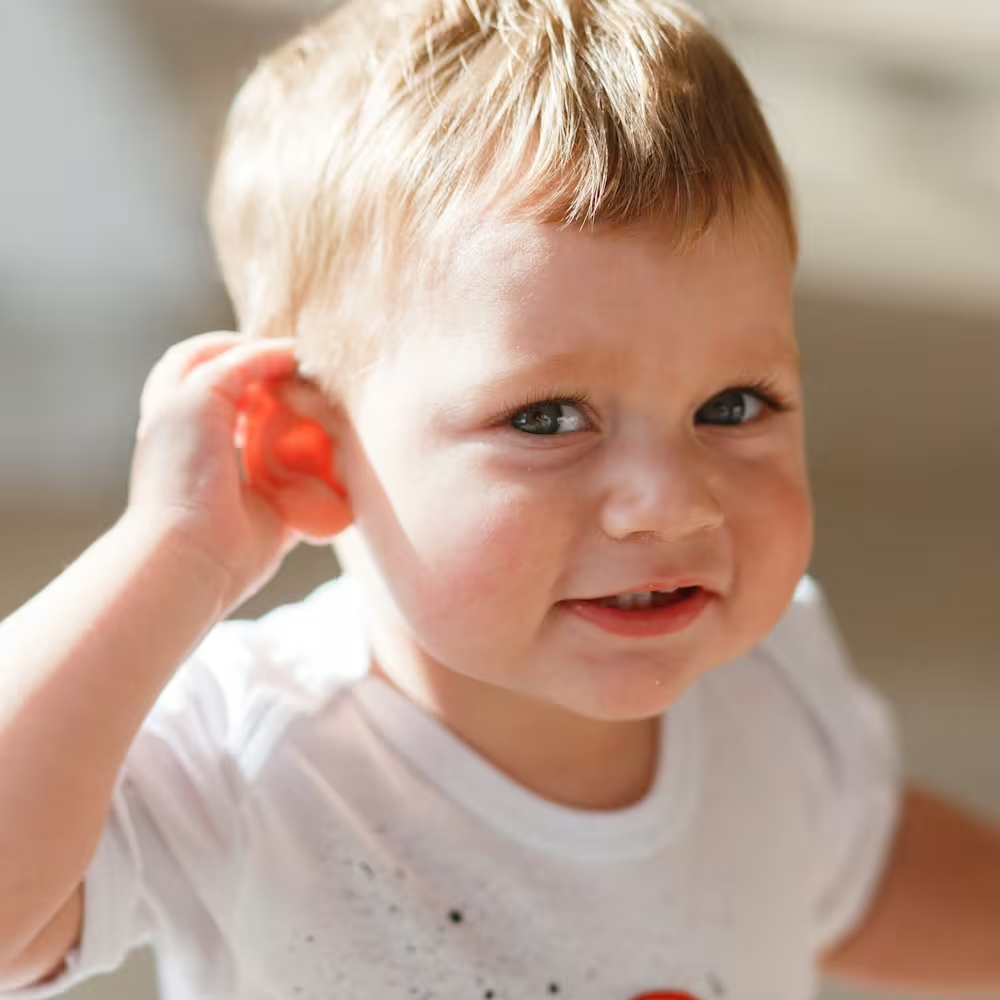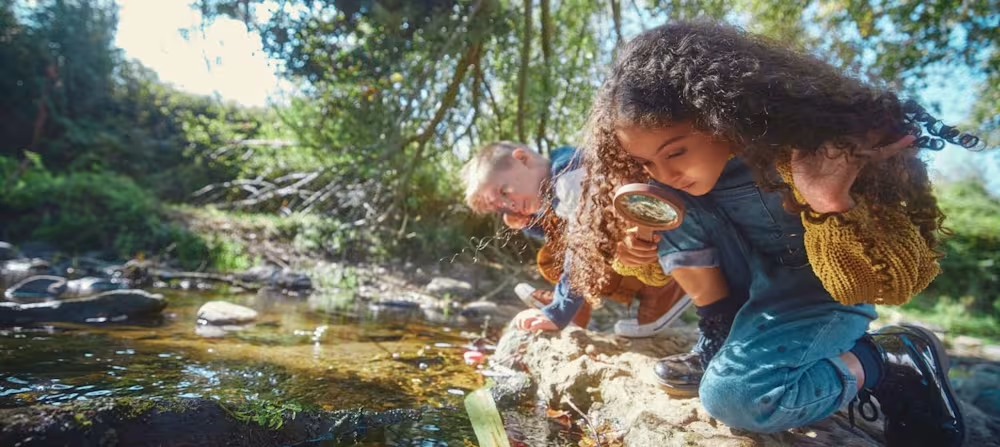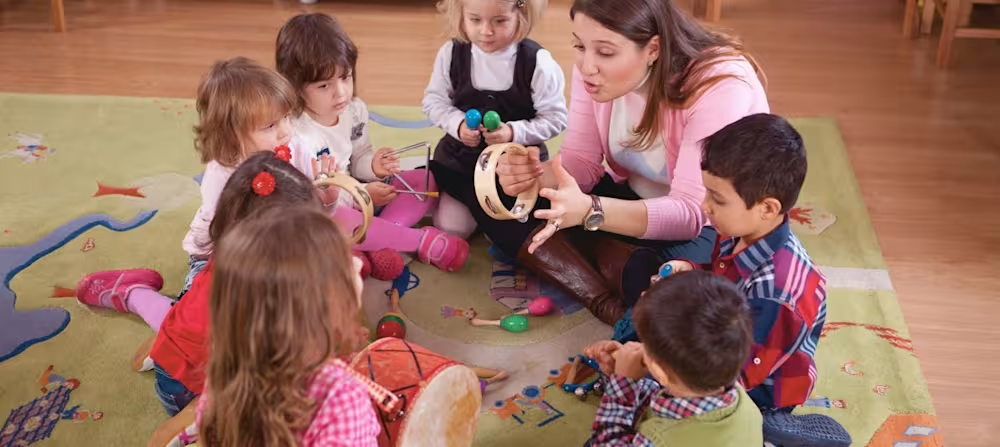5 year old child milestones: Development, growth, speech, language
Updated Dec 29, 2025

Is it hard to believe your “baby” is 5 and embarking on their school years? Once you’re done crying happy tears and wondering where time has gone, take a moment to relish how you’ve raised a wonderful human for half a decade! You may notice your child is able to do things like carry a conversation, dress themselves, write some letters, and is ready to take on the world (aka kindergarten).
In this article, we’ll take you through milestones you can expect at 5 - 6 years old, give you a handy 5 year old development checklist, and provide useful tips to help ensure your child is learning and growing as much as possible.
Editor's note
Not all children will reach 5 year old milestones at the same time — and that’s normal. Typically, children meet the milestones listed here between 5 and 6 years old, but that may not always be the case. If you have concerns about your child’s growth or if they may be a bit behind, it’s a good idea to chat with their doctor.
Table of Contents
5 year old milestones at a glance
Development:
At 5, your kiddo may seem much more like a big kid as they prepare to start kindergarten — some may have already started! This transition is an epic milestone for kids (and parents!) and it can be a tricky one to navigate as they adjust [] to a new schedule, environment, classmates, and more. The good news is that parents and other caregivers can start prepping kids early [] to help make the transition smoother.
Generally, 5 year olds are working on communication and social skills to set them up for success in school and beyond. At this age, kiddos can typically hold a conversation, engage in social activities with their peers, and are becoming better at distinguishing between fantasy and reality. They’re usually able to physically do things that require more agility and balance (hop, skip, swing), and have gained more precision using utensils and writing tools.
Sleep:
We recommend that 5 year olds get about 10 - 13 hours of sleep per day, which aligns with the American Academy of Pediatrics (AAP) [] recommendations for 3 - 5 year olds. The AAP recommendation changes to 9 - 12 hours for 6 - 9 year olds.
At this age, most children are not sleeping during the day, though they may still have rest time instead of a nap if they haven’t started kindergarten yet. If your kiddo is falling asleep in a puddle on the couch because they’re exhausted from a busy day of school, consider opting for an instead of daytime sleep. Naps may push bedtime late and shorten night sleep, which can create a cycle of overtiredness — especially for kiddos who are up early to go to school or daycare.
Potty training and sleep
While there’s no clear-cut age when children should stop using pull-ups or diapers for overnight sleep, most children display signs of readiness sometime after 4. Some signs that your 5 year old may be ready for include:
Your child consistently uses the potty during the day with minimal accidents for at least 6 months
Your child is not peeing overnight
Your child waits until early morning to wet the bed/diaper/pull-up
Your child wants to wear underwear to bed
Your child takes off their diaper/pull-up by themselves in the morning
Your child doesn’t need to urinate upon waking (indicating they’ve already gone in their nighttime diaper)
Your child is beyond the age of 4 years old
Keep in mind that all children are different — some may be ready for overnight potty training earlier or later than others. If your 5 year old isn’t ready yet, that’s OK. And if you’ve started the process of overnight potty training and your child is having accidents, that’s not uncommon either. Consult with your child’s doctor if you have questions or concerns about overnight potty training.
Feeding:
At around 5, kids usually eat around every during the day. However, they may go longer between meals, especially if they are in school. Serving a balanced, breakfast can help set your kiddo up for success, especially if they’re headed off to kindergarten for the day. Research shows [] that eating breakfast can positively impact school performance.
You may notice that your child’s picky eating tendencies fade and your kiddo may become a more adventurous and curious eater. We recommend continuing to offer a variety of foods and modeling healthy eating habits for your child at this age. It’s also great if you’re able to involve your 5 year old in making choices about their meal — even let them assist with food preparation from time to time. We know that cooking with kids can sometimes be a messy, frustrating endeavor but it can also be fun and rewarding!
Growth:
Physical growth remains steady between 5 - 6 years old. They may gain 4 - 5 pounds and grow 2 - 3 inches in height per year at this age [].
However, every kid is different! It can be normal for your child to grow more or less than this between 5 - 6 years old. At well-child visits, your child’s doctor will chart their height and weight to be sure they’re following their typical growth curve and to pinpoint any trends that need attention. You know your child best — if you have concerns about your child’s growth at 5 years old, consult their doctor.
5 year old development milestones
Physical development
Gross motor milestones
Improved coordination and balance: At 5, children typically have improved coordination [], meaning they can get their limbs and body to work together better than before. Balance improves too and your 5 year old may be skipping, hopping on one foot [], and jumping. They can likely stay balanced while standing on one foot with their eyes closed too []! Your kiddo may also be able to somersault, ride a bike (with training wheels [], most likely) navigate stairs without help, swing and climb [], and more.
Fine motor milestones
Eating: Five year old motor skills include being able to navigate eating utensils with more precision. They may be able to use a knife to carefully spread soft foods (be sure to supervise this).
Drawing: At 5, your kiddo may be able to draw a picture of you [] — a person, complete with a head, body, and limbs. (Well, the stick figure version of you, at least!) They can also likely copy drawing triangles and other shapes and write some lowercase and uppercase letters.
Getting dressed: Most 5 year olds can dress and undress themselves at this age — it can be a great way to practice problem-solving too. However, they may need help with more advanced skills, like tying their shoelaces [] or fastening small buttons.
Speech development
Conversations: By 5, children can usually keep a conversation going and participate in more than three back-and-forth exchanges []. It’s expected that they mostly talk in complete sentences that consist of five or more [] words. At this age, speaking is typically very clear. It likely doesn’t feel like too long ago that these kiddos were babbling and learning their first words!
Storytelling: Most 5 year olds can tell stories [] in complete sentences and use future tense, like “We’ll go to the park tomorrow.” These stories (either heard or made up) usually have at least two events. For example: “We’ll go to the park tomorrow and go down the slide.”
Rhyming: By 5, kiddos can typically use or recognize simple rhymes [](“ball” and “fall”).
Social development
Emotional development
Friends: Children in their kinder year may be more social and want to please their friends [] and be like them too. However, since kids at this age can also express likes and dislikes better (they sure can be blunt!), they may not get along with [] their peers all of the time. This is normal!
Fantasy vs. reality: 5 year olds are better able to distinguish between [] fantasy and reality, but this doesn’t mean that they no longer enjoy playing make-believe and dress-up. Imaginative play is important [] for social and emotional development and helps them understand teamwork and different perspectives.
Following rules: You may be relieved that 5 year olds are typically more agreeable [] to rules most of the time — which is likely an improvement from those feisty toddler years! However, they are likely to question others [] (especially parents) often, which is a normal part of their growing independence. Generally, they also recognize when they make mistakes and say “I’m sorry.”[
Cognitive development
Numbers: At 5, kiddos typically have improved math skills [] and can count to at least 10 (and counts 10 or more objects). They can also name some numbers [] (1 - 5) when you point to them.
Colors: Kids can usually correctly name [] at least 4 colors at this age.
Letters: By 5, children may be able to name some letters [] when you point to them. Kiddos can often recognize their printed name and write some of the letters themselves. By 6, your child may be able to spell [] and write their first name!
Reading: Some kids may be working on sounding out simple words at 5. However, don’t fret if your child isn’t reading independently in kindergarten. Between 5 - 6, your little one may begin to recognize some familiar words when they see them printed []. They’re also possibly starting to identify sounds in short words (“sh” in “shut”). These skills will evolve in the coming years. Children usually begin to read and sound out words [] between 6 - 7.
5 year old development milestones checklist
Keep in mind that kids grow and develop at different rates. Your 5 year old may have already met all of the below milestones or they may not be there quite yet — and that’s OK! However, if you’re concerned about your child’s growth or any potential developmental delays, reach out to their healthcare provider.
Stay balanced while standing on one foot with eyes closed
Hop on one foot
Somersault
Ride a bike (with or without training wheels)
Use eating and writing utensils with precision
Draw a “person” with a few body parts
Write some uppercase and lowercase letters
Dress and undress themselves (with help tying shoelaces etc.)
Keep a conversation going with three or more back-and-forth exchanges
Talk in complete sentences consisting of 5+ words
Tell stories
Use future tense (“We’ll go to the party next week”)
Make simple rhymes (“cat” and “bat”)
Aim to please their friends and be like them
Distinguish between fantasy and reality
Be more agreeable to rules
Count to 10 and count 10+ objects
Name some numbers and letters
Correctly name 4+ colors
What are 5 year old developmental red flags?
Children develop and grow at their own pace. However, there are some signs at 5 years old that may warrant a discussion with your doctor. Reach out if you notice any of the following []:
Doesn’t display a range of emotions
Is unusually fearful, aggressive, shy or sad
Child is excessively withdrawn and not active
Is easily distracted, and has trouble focusing on one activity for more than five minutes
Isn't responding to people or only responds superficially
Can't tell the difference between what's real and make-believe
Doesn’t play a variety of games and activities
Doesn't know their first and last name
Doesn’t draw pictures
3 development tips for 5 year olds
Tip | Why it helps | How to put it into practice |
|---|---|---|
Support group play and teamwork | Playing with peers strengthens social skills, emotional flexibility, imagination, and the ability to collaborate. | Set up playdates or group activities, and coach your kiddo through any conflicts as needed. |
Make reading joyful and inviting | Positive reading experiences help build early literacy skills, curiosity, and confidence. Kids learn best when books feel fun. | Let them choose books, trade “reading” roles, or create a cozy reading nook. Visit the library and include books in daily routines. |
Talk often and check in emotionally | With growing independence, kids need space to share their feelings. Regular conversations build trust and emotional awareness. | Ask open, simple questions about their day. Listen closely, praise their efforts, and help navigate tricky moments with reassurance. |
Find more details below:
Tip #1: Encourage play with other kids
Engaging with peers is typically fun for kiddos and it helps them develop social, emotional, and cognitive [] skills too. At this age, it’s exciting to see how kiddos play together as their imaginations soar. You may find 5 year olds can play together longer and work together on a goal (building a giant fort, for example) or align on a theme (pretending they’re doctors). Children at this age also squabble over which game to play or sharing their favorite things [] — this is common behavior at 5.
Tip #2: Make reading fun
You’ve likely been reading with your child for most of their life — how amazing! Continuing to read and expose your child to books helps them learn and grow and can lead to them becoming a better reader in the [] future. To keep your kiddo interested in reading, aim to make it an enjoyable daily experience. Here are some ways you can try to make reading fun at this age:
Let your child pick the book(s)
Read “together” (you read your book and they can “read” theirs)
Create a special reading area in your home or your child’s room
Add reading into your kiddo’s daily routine
Ask your child to “read” the book to you and trade off
Go to the library together to pick out new books to read
Tip #3: Talk to your kiddo and keep tabs on their feelings
As your child starts school and becomes more independent at 5, talking to them [] about their feelings (towards school, teachers, classmates, etc.) can help you support their learning and emotional needs. Ask your kiddo about things they like and dislike and let them have a chance to express their ups and downs each day while leaning on you for support. Encourage and praise your child for their efforts and achievements and also aim to help them navigate any shortcomings. Setting a foundation for open communication can help maintain this relationship as the years go on.
Activities for kids at 5 years old
1. Assign age-appropriate chores
While your 5 year old may complain about doing chores, research shows that children can benefit from regularly having age-appropriate responsibilities. Benefits may include []:
Higher levels of self-esteem
Development of time management and organizational skills
Being more responsible and independent
Providing an opportunity for success
Handling frustration, adversity, and delayed gratification
Greater success in school, work, and relationships due to the above skills
Here are some ideas of chores that may suit your 5 year old:
Feeding pets
Setting and clearing the table at mealtimes
Putting dirty clothes in the hamper
Cleaning up their toys at the end of each day
Help unload the dishwasher (with supervision and being mindful of breakable/sharp items)
2. Play games and/or sports
Games and sports [] are ideal for kids at 5 for many reasons, including encouraging your child to be physically active, strengthening sensory-motor skills, teaching them rules, developing social skills (like being a good sport and taking turns), and getting them to interact with other kids. Whether a game at the kitchen table or an organized sport, these activities can help your kiddo learn and grow.
Caring for a sick child at 5 years old
It's tricky when kids are under the weather, especially at 5 when they may want to push through and continue to go to school and play. Focus on hydration, comfort, and rest as much as possible.
Hydration: Encourage your child to drink water regularly throughout the day. Offer popsicles, soup, or smoothies if they’re not up for drinking plain water.
Nutrition: Appetite may dip when they’re not feeling well. Provide small, easy meals and familiar healthy snacks. There’s no need to force eating, as staying hydrated is most important.
Fever: Call your pediatrician if your child’s fever lasts more than 24 hours or repeatedly rises above 104°F (40°C) []. If recommended by their doctor, you can use children’s Tylenol or Motrin. Avoid over-the-counter cough and cold medicines, as they aren’t safe for young children.
Rest & routines: Illness can disrupt normal routines — even big kids might nap or need earlier bedtimes. Encourage quiet time, extra sleep, and a calm environment until your child feels better, then gradually return to their usual schedule.
Comfort: At 5, children often tell you what helps them feel better. Offer extra snuggles, calm reassurance, and flexibility too. Caring for a sick child can be exhausting, so don’t hesitate to ask for help if you need it.
When to seek help
If your child has a fever for more than 24 hours or it reaches above 104°F (40°C), call their doctor right away. These can be signs of a more serious infection or illness and it's best to rule out anything that needs medical attention.
In general, if something feels off or you’re worried about how your child looks or acts, it’s safest to check in with their doctor. And if you already talked to them but symptoms appear worse, that’s a good time to check back in too.
Takeaway
Your child may have started kindergarten already or school may be right around the corner. It can be a bittersweet time for parents, but one filled with excitement as your kiddo reaches milestones and gains more independence. Most 5 year olds are learning and growing every day, both in and out of the classroom.
At 5, kids can likely do physical activities that require more balance and coordination, like skipping, hopping, and climbing. When it comes to fine motor skills, they may start writing letters, drawing “people” (stick figures), and using eating utensils with more precision.
Kids between 5 - 6 are continuing to hone their social skills. There are many benefits to interacting with other children (whether in school, sports, etc.) to learn skills like problem-solving, cooperating, negotiating, and conflict.
These are general guidelines for development at 5 years old. There’s a wide spectrum of normal when it comes to milestones for kids and it’s OK if yours isn’t doing all of these things by 5. That said, consult with your child’s healthcare provider if you notice any developmental red flags, delays, or have questions about your child’s growth.
5 year old development milestones FAQs
Share article:
Note: The content on this site is for informational purposes only and should not replace medical advice from your doctor, pediatrician, or medical professional. If you have questions or concerns, you should contact a medical professional.
17 Sources
Table of Contents
Share article:





